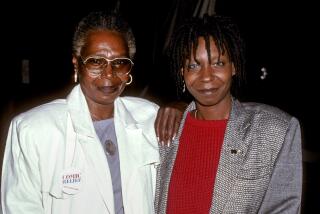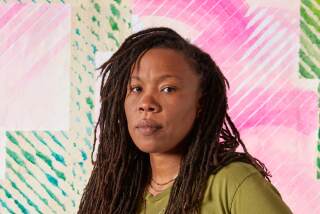A mother’s love of India
- Share via
It was spring when Chandrasekhar Acarya Das took his mother’s ashes to India. He carried them into the Ganges River, placed the urn in the water, then turned and swam back to shore outside Myapur, world headquarters of the International Society for Krishna Consciousness.
India is a mystical and timeless land. For those in search of reason or God, many roads lead there. Das, born Cyril Wohrer, went there on a search for meaning; his mother, Tara Colburn, went there searching for him. Their journeys took them to different worlds, but, for that final moment, they came together in the current of a holy river.
Friends say Colburn, one of the founding board members of the Los Angeles Opera, never stopped hoping her son would leave the Hare Krishna movement. She positioned herself as a bridge in hopes that he might come to her.
Colburn made her first trip to India in 1993. She returned two or three times a year, not only to see her son but also to travel to remote areas of the country, primarily Orissa and Rajasthan states, where she became enthralled by tribal life. It spoke to her, and she spoke back through photography.
That work -- “A Mother’s Journey: Photographs From Orissa, India by Tara Colburn” -- is on display for the first time in the U.S. at the UCLA Fowler Museum of Cultural History, beginning Sunday. When not on display, her photos are housed in the Department of Special Collections at UCLA’s Charles E. Young Research Library.
Colburn’s images were of everyday life: a woman offering water to the sun god, a girl on the way to the market, young women locking arms and dancing to celebrate a successful hunt.
Michael L. Tenzer, a friend and confidant, is a former staff photographer for Look magazine. He and Colburn met through the L.A. Opera, where both served on the board of directors. “The camera was a natural instrument in her hands,” he said. “Tara was an extremely creative, gifted person. She loved opera and was moved by opera as much as anyone could be.”
When she started photographing India, she would approach Tenzer with questions; she also would confide in him about her son, a graduate of the Crossroads School in Santa Monica who had dropped out of Cornell University.
“She accepted her son’s conversion to the Hare Krishna movement, but it was difficult for her emotionally,” Tenzer said. “She was conflicted. Her love for him was enormous, and his disengagement from the world she knew was painful to her.”
In explaining her work and her relationship with India for an exhibition in 1998, she wrote that the International Society for Krishna Consciousness was a cult that carried her son off to India. “My love and longing for him compelled me to follow him, striving to maintain an affectionate relationship and hoping that someday he might come back to live a normal life. I was prepared to hate India. Instead I fell in love with it.”
Her last trip to India was earlier this year, when she met her son at the Ambassador Hotel in Delhi to tell him that she had cancer. They spent the better part of two days reminiscing and looking at old photographs.
“It was like a stroll down memory lane,” Das said. “Do you remember this, do you remember that? Do you remember when I used to say that to you, when I cut your ear while I was cutting your hair and there was blood all over and I started crying and when you saw me crying you started to cry?”
He wanted her to stay in India for whatever time remained, and she almost agreed. When it came time for him to leave, she hugged him, he says, and looked him straight in the eyes. “Become a very good Hare Krishna,” she said. He walked out of the room, and she walked out on the balcony to watch him leave. She told herself that if he turned and looked back at her, she would stay and die in India. She watched and waited, but he never looked back.
SHE was born Tarasenka Pankiv in Zagreb, Croatia. Her grandfather was director of the Conservatory of Zagreb, and her mother was a concert pianist who performed throughout Europe. Colburn learned to play the piano at an early age.
She lived with her grandmother for about six years after her parents were taken as political prisoners during the regime of Yugoslavian leader Josip Broz Tito. Her father, active in politics, was eventually executed. On Saturdays and Sundays throughout her mother’s incarceration, Colburn would stand with her grandmother outside the prison and look up to the sixth floor, where they believed her mother was held.
During that time, all was taken from the family, and there was little food to eat or wood to burn for heat. It was music, she would say later, that sustained her and gave her hope.
Her mother was eventually released. At age 13, Colburn and her mother fled to Germany. They later went to Paris, and when Colburn was about 15, they came to the United States, first to Chicago, then L.A. In America, Colburn studied gem analysis and design and worked as a model and secretary.
She was married and divorced twice, first to John Glynn, an attorney, and later to Richard Colburn, one of the city’s more substantial benefactors of the arts. Between marriages, she fell in love with a man from Paris and lived with him in Mexico. It was through this relationship that Cyril was born.
It was on marrying Colburn that she became involved in the L.A. Opera, which became her passion.
“We both stepped up the social and financial ladder,” Das, now 30, says of his mother’s marriage to Colburn. “But money didn’t really change her. She was very selfless. She sacrificed so much for me, for my education and happiness.”
He says he decided in 1993 to join the Hare Krishna movement after reading the words of His Divine Grace A.C. Bhaktivedanta, founder of the movement, and meeting His Holiness Bhakti Charu Swami, for whom he now serves as personal assistant.
“Coming out of high school, I had been there, done that,” he says. “I had traveled the world, spoke three languages, been to prestigious schools, was accepted to Cornell. I had been to the fanciest restaurants, resorts, museums around the world, but I always had this fascination with ancient civilizations and philosophy.”
He says that in the Krishna movement, he found a way of life that suited him. At the time of his decision, his mother was with a tour group, traveling in India for the first time. When she returned, he told her of his decision.
Both their paths had turned toward India.
Colburn’s guide, Sarat Acharya, says they made 14 trips into the tribal areas of India. Many of her photographs, he said, were of mother and child. “She could visualize the loving face of her missing son in each and every tribal child of Orissa.”
In a 1998 article in the Indian Express, Colburn was quoted as saying, “In comparison with the West, nobody, not even a beggar, is homeless here. Everybody belongs somewhere, whereas we in the West vacillate in our solitude.”
She said she was drawn to the people of India because of their ability to find joy despite poverty and other hardships. She wrote that her photographs were “illustrations for an ancient tale about suffering and wisdom, life and hope.”
After her diagnosis in November, Colburn focused on arrangements for her estate. She went through her possessions and detailed what should be done with each item. Most were to be sold to benefit L.A. Opera.
She didn’t want to die in her home, concerned that it might somehow darken the spirit of the place for its new occupants.
On her final trip to India, she was accompanied by Arundhati Sen Neuman, a friend she met through Neuman’s husband, Daniel, an ethnomusicologist and executive vice chancellor at UCLA.
Colburn left about 50,000 images of India in Arundhati Sen Neuman’s care, and in Colburn’s final days, they went through many of the slides, one by one, so Colburn could provide background information.
At one point, she described her pursuit of India’s wondrous light, which turns rich and warm in late afternoon. She and her guide would rush to make use of the precious light, she said, driving and searching for the right angles, the right subject matter until, all too quickly, darkness came.
“Then, suddenly,” she said, “everything goes silent, and the lights go on along the way, and then you hear the radio music. We slept in the village, or along the way, there are some rest houses
By then, Colburn was very weak, and airline officials were hesitant to allow her on the flight. Toporkova convinced them she would be fine, but by the time they reached Geneva, Colburn couldn’t walk.
They checked into a hotel in Geneva. Soon after, Colburn, 61, was transported to a hospital, where she entered a coma.
Although doctors said Colburn could not hear, Toporkova believed otherwise. “Cyril’s coming,” she would whisper. Das was making his way to Geneva from North Carolina. Upon hearing of his mother’s condition, he contacted Swiss friends, who delivered tulsi beads to Colburn, then prayed for her.
Das arrived two hours after she died on May 23.
In the Hindu faith, the Ganges River sometimes is referred to as a mother goddess and is said to flow not only through India but also through the universe, sanctifying all that it touches.
Colburn’s journey ended there, as her ashes were placed in an urn made of mud from the river, then released into its current. It was midday when mother and son parted ways, the time of day when Colburn would have been anticipating the sunset that would soon wash the landscape, followed by the slow unfolding of darkness, when she would close her eyes and listen to the song of birds and India.
*
‘A Mother’s Journey’
Where: UCLA Fowler Museum of Cultural History, in the northern part of campus, Westwood
When: Opens Sunday. Wednesdays-Sundays, noon to 5 p.m.; Thursdays, noon to 8 p.m. Closed Mondays and Tuesdays. Ends Feb. 29.
Cost: Free. UCLA parking, $7
Info: (310) 825-4361
Duane Noriyuki can be contacted at duane.noriyuki@latimes.com.
More to Read
The biggest entertainment stories
Get our big stories about Hollywood, film, television, music, arts, culture and more right in your inbox as soon as they publish.
You may occasionally receive promotional content from the Los Angeles Times.










